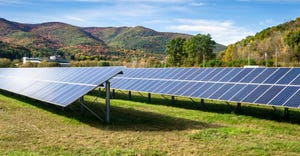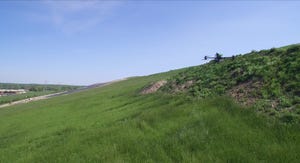A High Flying Recycling Program 1917
October 1, 2000
Jim Tabor
One part of the United States Air Force does its best work on the ground.
Dyess Air Force Base, tucked into the southwest corner of Abilene, Texas, has become a model recycler, especially for military installations. Covering 6,117 acres, the base hosts 1,136 family housing units, 8 dorms with 552 rooms and more than 300 facilities. Dyess employs 5,000 people, operates three runways and is home to B-1B bombers and the C-130.
The base currently recycles all types of materials: aluminum cans, corrugated cardboard, paper and plastic sacks, fiberboard, all food and beverage glass containers, all types of paper, plastics, steel, and all wood products. In fact, the only items going to the landfill are personal hygiene and food debris. As a result, Dyess now leads the Air Force in reducing the amount of landfilled waste.
In addition, in 1995, the state of Texas selected Dyess as a recycling benchmark facility. Four years later, Air Combat Command recognized the recycle quality assurance evaluator as the best in the Air Combat Command.
What has Dyess accomplished to garner so many awards? Primarily, the base has been recognized for the dramatic results of its recycling program. In fiscal year 1992, the base landfilled 6,039 tons or 5.25 pounds per person compared to fiscal year 1999, when the base landfilled 1,304.08 tons or 1.13 pounds per person.
Thanks to the recycling program's success, it will take 70 years to fill the base's landfill at the current disposal rate.
In the Beginning
Like most major accomplishments, it took years of study, planning and modifications to reach this plateau. Dyess created its recycling program through a series of steps beginning in the early 1990s. First, the base surveyed the materials being landfilled between 1992 and 1993. Heading the list was grass clippings, weighing in at 600 tons per year. The contractor immediately stopped bagging the clippings, and the housing section personnel also were encouraged to do the same. In addition, the base instituted a “back to nature program,” which reduced the number of acres mowed in remote areas.
The results were immediate; the base diverted more than 500 tons of grass clippings from landfills.
In 1993, Dyess also studied the amount of cardboard, aluminum cans, paper, plastic bottles, leaves and limbs headed to the landfill.
The study confirmed that 80 percent of the material going to the landfill could be recycled. In addition, 90 percent of the diverted materials contained recyclable content.
Based on this, the Dyess' deputy civil engineer, and the base's environmental flight decided the direction of its recycling program. Housing residents received two containers: one for edible and personal hygiene items and another for the rest. Personal hygiene and edible items would be landfilled; everything else would go to the recycling center.
The base hired an operator to run the recycling facility. The contractor provides all personnel, equipment, tools, materials, supervision, transportation, and other items and services for waste collection, minimization, handling and processing, composting and disposal, as well as for the sale of recyclables.
Dyess requires that 80 percent of the base's solid waste and 90 percent of the material processed through the facility must be recycled. The base receives all revenues from the sale of recyclable materials.
By 1998, however, the base found that only 61 percent of its solid waste was diverted to the recycling facility. Of that amount, the contractor recycled 80 percent.
More Could Be Done
After a study in March 1999, the base discovered more potential recyclables. Of the 124,870 pounds headed to the landfill generated by family housing, 99,896 pounds were recyclables; the rest of the base's 73,130 pounds going to the landfill yielded 47,534 pounds of recyclables.
The recycling efforts, however still were falling short of Dyess' overall goals. After months of study, Dyess found communication, education and improper container size were the shortcomings in its recycling efforts.
First, the base concentrated on why family housing was not recycling. The reason proved simple: the 90-gallon recycling container wasn't large enough for all the recyclables and the other 90-gallon container was too large for landfill waste.
To determine the appropriate container sizes, a random sample was taken from 20 different households: 10 with two adults and two children, one in diapers; five with two adults and two children, both in diapers; and five with two adults and three children, one in diapers.
The results were very interesting because no matter the household size, a 20-gallon container was sufficient for one week unless the family had more than one child in diapers. Then, a second container was necessary.
The program added a 20-gallon landfill container and switched the 90-gallon landfill container to a second recyclables container.
Finally, by April 1999, Dyess achieved its original recycling goals. From April 1999 to January 2000, Dyess diverted 3,036 tons to the recycling facility, and only 698 tons were landfilled. Of the 3,036 tons at the recycling facility 2,784 tons were recycled with only 252 tons landfilled. This means 2,784 tons were recycled and only 950 tons were landfilled.
Currently, the materials recycled include: aluminum cans, miscellaneous aluminum materials, cardboard, cloth, compost (leaves and limbs), crushed glass, metals, newspaper, white paper, plastic bags, plastic bottles, “hard plastics” (i.e. toys, playground equipment, hangers, clothesbaskets etc.), steel, Styrofoam, tires, wood, and wood chips. The contractor also gives away materials in a “last look” area.
Marketing is the toughest job faced by the base and contractor. Because the local area doesn't yield many buyers, the base is developing a website promoting recycling and the recyclables inventory.
The homepage will include information on the recycling facility, the composting and mulch facilities, family and non-family housing waste reduction and recycling, and marketing recycled commodities. The site also includes household hazardous waste disposal information, upcoming events, general environmental issues, and more.
In April 1999, the environmental homepage went live. More than 500 hits occurred between May and December 1999.
C&D Not Counted
Construction debris is about 33 percent of Dyess' total solid waste, although it is not counted as being landfilled. Presently, all construction debris must go either to a permitted facility in Abilene, or to an approved back-fill site.
The base intends to purchase a shredder by 2005, which will handle most construction debris at the recycling facility. The shredder will separate the metals, which will be recycled from the base material, then will be used as road base. Dyess plans to reduce this waste stream by 90 percent by 2005.
Where Do the Recyclables Go?
Dyess successfully sells and/or gives away all waste streams except for cloth, hard plastics (i.e. toys, playground equipment, hangers, clothesbaskets etc.) Styrofoam and used tires. Dyess currently is working with a local company to use the cloth as rags.
Plastic bottles made with either polyethylene terephthalate (PET) or high-density polyethylene (HDPE) are easy to recycle. However, these types of plastic only constitute 23 percent of all the plastics at the facility. So far, no markets have been found for the other 77 percent, which are hard plastics and plastic bags.
Dyess will continue trying to find markets for this type of plastic, as well as for Styrofoam and used tires.
Dyess is considering purchasing shredders or grinders to reduce the items' size, which will make them easier to market.
The base either sells or gives away the other recyclables. Wood products are sold or given away, while virgin (non-chemical added) wood is chipped for vegetation cover and protection. In addition to being used by the base, wood chips are given free locally to the zoo, schools and feed lots. Treated wood is transported to the free last look area along with other miscellaneous materials such as mattresses.
After removing all metal and/or plastic caps, glass containers are crushed into sand size media. When irrigation breaks occur, the crushed glass is used as backfill with the final foot filled with topsoil.
Aluminum cans, miscellaneous aluminum materials, cardboard, compost (leaves and limbs), metals, newspaper, white paper, and steel are regularly recycled.
In 1999, Dyess successfully marketed 451 tons of cardboard, 162 tons of newspaper, 156 tons of white paper, and 377 tons of wood chips.
The Inspection Program
The recycling facility inspection program includes best management practices in stormwater discharge. Quarterly inspections include all designated areas of the facility and equipment in the stormwater pollution prevention plan.
The inspection includes tracking and conducting follow-up actions based on the inspection's results. The inspected areas include the material storage areas, material unloading and loading areas (including rail sidings) that are exposed to either rain or stormwater runoff, and all erosion and sediment.
The best management plan inspection concentrates on outdoor vehicle and equipment maintenance areas. This includes the vehicle and equipment fueling areas, and all areas where waste is generated, received, stored, treated or disposed and are exposed to either rain or stormwater runoff.
So far, samples never have been above the minimum acceptable requirements.
Dyess' also recycles petroleum-related liquids and solids, batteries, and fluorescent light bulbs. The petroleum-related liquids, including those removed from the solids are refined or used in energy recovery. The base sends the solids out for energy recovery.
Battery recycling includes lead acid. Nickel-cadmium, silver oxide, lithium, and magnesium batteries soon will be recycled. Fluorescent light bulbs are recycled for the mercury and glass.
The recycling program on Dyess Air Force base is one of the premier programs in the state of Texas and in the Air Force. Two main factors contribute to its success: The program is user friendly, and 100 percent of base personnel can participate.
Although recycling is a task, Dyess determined there were many benefits. The short-term benefits include a reduction of land needed for landfilling, reduced consumption of labor and petroleum products, a decrease in air pollution and a sense of personal accomplishment.
Long-term benefits include saving natural resources, less dependence on foreign products and the assurance that future generations can enjoy the many things people value today.
Jim Tabor [[email protected]] is a team member of 7th CES/CEVA environmental program and works as the National Environmental Policy Act program manager at Dyess Air Force base, Abilene, Texas.
You May Also Like


